Development of 340-GHz Transceiver Front End Based on GaAs Monolithic Integration Technology for THz Active Imaging Array
Abstract
:1. Introduction
2. Materials and Methods
2.1. Schottky Diodes
2.2. Geometry Optimization of Diodes
2.3. 0.34 THz Tripler Development
2.4. 0.34 THz SHM Development
2.5. Tolerance Analysis
3. Results and Discussions
3.1. 0.34 THz Triplers’ Performances
3.2. 0.34 THz Mixers’ Performances
4. Conclusions
Author Contributions
Funding
Conflicts of Interest
References
- Anwar, M.; Fischer, B.M.; Dhar, N.K.; Demarty, Y.; Schneider, M.; Crowe, T.W.; Löffler, T.; Keil, A.; Quast, H. THz all-electronic 3D imaging for safety and security applications. In Proceedings of the SPIE 7671, Terahertz Physics, Devices, and Systems IV: Advanced Applications in Industry and Defense, Orlando, FL, USA, 26 April 2010; Volume 7671, p. 767111. [Google Scholar] [CrossRef]
- Hillger, P.; Grzyb, J.; Jain, R.; Pfeiffer, U.R. Terahertz Imaging and Sensing Applications With Silicon-Based Technologies. IEEE Trans. Terahertz Sci. Technol. 2019, 9, 1–19. [Google Scholar] [CrossRef]
- Hwu, R.J.; Zimdars, D.; Woolard, D.L.; White, J.S. Terahertz reflection imaging for package and personnel inspection. In Proceedings of the SPIE 5411, Terahertz for Military and Security Applications II, Orlando, FL, USA, 8 September 2004; Volume 5411, p. 78. [Google Scholar] [CrossRef]
- Kawase, K. Terahertz Imaging For Drug Detection And Large-Scale Integrated Circuit Inspection. Opt. Photonics News 2004, 15, 34–39. [Google Scholar] [CrossRef]
- Kawase, K.; Shibuya, T.; Hayashi, S.i.; Suizu, K. THz imaging techniques for nondestructive inspections. Comptes Rendus Phys. 2010, 11, 510–518. [Google Scholar] [CrossRef]
- Kulesa, C. Terahertz Spectroscopy for Astronomy: From Comets to Cosmology. IEEE Trans. Terahertz Sci. Technol. 2011, 1, 232–240. [Google Scholar] [CrossRef]
- Liu, H.-B.; Zhong, H.; Karpowicz, N.; Chen, Y.; Zhang, X.-C. Terahertz Spectroscopy and Imaging for Defense and Security Applications. Proc. IEEE 2007, 95, 1514–1527. [Google Scholar] [CrossRef]
- Shen, Y.C.; Lo, T.; Taday, P.F.; Cole, B.E.; Tribe, W.R.; Kemp, M.C. Detection and identification of explosives using terahertz pulsed spectroscopic imaging. Appl. Phys. Lett. 2005, 86, 241116. [Google Scholar] [CrossRef] [Green Version]
- Trichopoulos, G.C.; Mosbacker, H.L.; Burdette, D.; Sertel, K. A Broadband Focal Plane Array Camera for Real-time THz Imaging Applications. IEEE Trans. Antennas Propag. 2013, 61, 1733–1740. [Google Scholar] [CrossRef]
- Appleby, R.; Anderton, R.N. Millimeter-Wave and Submillimeter-Wave Imaging for Security and Surveillance. Proc. IEEE 2007, 95, 1683–1690. [Google Scholar] [CrossRef]
- Cooper, K.B.; Dengler, R.J.; Llombart, N.; Bryllert, T.; Chattopadhyay, G.; Schlecht, E.; Gill, J.; Lee, C.; Skalare, A.; Mehdi, I.; et al. Penetrating 3-D Imaging at 4- and 25-m Range Using a Submillimeter-Wave Radar. IEEE Trans. Microw. Theory Tech. 2008, 56, 2771–2778. [Google Scholar] [CrossRef] [Green Version]
- Cooper, K.B.; Dengler, R.J.; Llombart, N.; Thomas, B.; Chattopadhyay, G.; Siegel, P.H. THz Imaging Radar for Standoff Personnel Screening. IEEE Trans. Terahertz Sci. Technol. 2011, 1, 169–182. [Google Scholar] [CrossRef]
- Friederich, F.; Von Spiegel, W.; Bauer, M.; Meng, F.; Thomson, M.D.; Boppel, S.; Lisauskas, A.; Hils, B.; Krozer, V.; Keil, A.; et al. THz Active Imaging Systems With Real-Time Capabilities. IEEE Trans. Terahertz Sci. Technol. 2011, 1, 183–200. [Google Scholar] [CrossRef]
- Heinz, E.; May, T.; Born, D.; Zieger, G.; Anders, S.; Zakosarenko, V.; Meyer, H.G.; Schäffel, C. Passive 350 GHz Video Imaging Systems for Security Applications. J. Infrared Millim. Terahertz Waves 2015, 36, 879–895. [Google Scholar] [CrossRef]
- Chattopadhyay, G. Terahertz circuits, systems, and imaging instruments. In Proceedings of the 2014 39th International Conference on Infrared, Millimeter, and Terahertz waves (IRMMW-THz), Tucson, AZ, USA, 14–19 September 2014; pp. 1–2. [Google Scholar]
- Zhang, B.; Ji, D.; Fang, D.; Liang, S.; Fan, Y.; Chen, X. A Novel 220-GHz GaN Diode On-Chip Tripler With High Driven Power. IEEE Electron Device Lett. 2019, 40, 780–783. [Google Scholar] [CrossRef]
- Yang, Y.; Zhang, B.; Wang, Y.; Niu, Z.; Fan, Y. Development of High Power 220 GHz Frequency Triplers Based on Schottky Diodes. IEEE Access 2020, 8, 74401–74412. [Google Scholar] [CrossRef]
- Li, Y.; Goh, W.L.; Liu, C.; Cui, B.; Liu, H.; Xiong, Y.Z. A 324-GHz Source/Modulator With −6.5 dBm Output Power. IEEE Trans. Terahertz Ence Technol. 2015, 5, 412–418. [Google Scholar] [CrossRef]
- Vu, T.A.; Takano, K.; Fujishima, M. 300-GHz Balanced Varactor Doubler in Silicon CMOS for Ultrahigh-Speed Wireless Communications. IEEE Microw. Wirel. Compon. Lett. 2018, 28, 341–343. [Google Scholar] [CrossRef]
- Chattopadhyay, G. Technology, Capabilities, and Performance of Low Power Terahertz Sources. IEEE Trans. Terahertz Sci. Technol. 2011, 1, 33–53. [Google Scholar] [CrossRef]
- Mehdi, I.; Siles, J.V.; Lee, C.; Schlecht, E. THz Diode Technology: Status, Prospects, and Applications. Proc. IEEE 2017, 105, 990–1007. [Google Scholar] [CrossRef]
- Martin, S.; Nakamura, B.; Fung, A.; Smith, P.; Bruston, J.; Maestrini, A.; Maiwald, F.; Siegel, P.; Schlecht, E.; Mehdi, I. Fabrication of 200 to 2700 GHz multiplier devices using GaAs and metal membranes. In Proceedings of the International Microwave Symposium Digest, Phoenix, AZ, USA, 20–24 May 2001. [Google Scholar]
- Maestrini, A.; Mehdi, I.; Lin, R.; Siles, J.V.; Ward, J. A 2.5–2.7 THz room temperature electronic source. In Proceedings of the International Symposium on Space Terahertz Technology, Tucson, AZ, USA, 26–28 April 2011. [Google Scholar]
- Porterfield, D.W. High-Efficiency Terahertz Frequency Triplers. In Proceedings of the International Microwave Symposium, Honolulu, HI, USA, 3–8 June 2007. [Google Scholar]
- Treuttel, J.; Gatilova, L.; Maestrini, A.; Moro-Melgar, D.; Yang, F.; Tamazouzt, F.; Vacelet, T.; Jin, Y.; Cavanna, A.; Mateos, J. A 520–620-GHz Schottky Receiver Front-End for Planetary Science and Remote Sensing With 1070 K–1500 K DSB Noise Temperature at Room Temperature. IEEE Trans. Terahertz Ence Technol. 2016, 6, 148–155. [Google Scholar] [CrossRef]
- Thomas, B.; Maestrini, A.; Beaudin, G. A low-noise fixed-tuned 300-360-GHz sub-harmonic mixer using planar Schottky diodes. IEEE Microw. Wirel. Compon. Lett. 2005, 15, 865–867. [Google Scholar] [CrossRef]
- Schlecht, E.; Siles, J.V.; Lee, C.; Lin, R.; Thomas, B.; Chattopadhyay, G.; Mehdi, I. Schottky Diode Based 1.2 THz Receivers Operating at Room-Temperature and Below for Planetary Atmospheric Sounding. IEEE Trans. Terahertz Ence Technol. 2014, 4, 661–669. [Google Scholar] [CrossRef]
- Sobis, P.J.; Wadefalk, N.; Emrich, A.; Stake, J. A Broadband, Low Noise, Integrated 340 GHz Schottky Diode Receiver. IEEE Microw. Wirel. Compon. Lett. 2012, 22, 366–368. [Google Scholar] [CrossRef]
- Chen, Z.; Wang, H.; Alderman, B.; Huggard, P.; Zhang, B.; Fan, Y. 190 GHz high power input frequency doubler based on Schottky diodes and AlN substrate. Ieice Electron. Express 2016, 13, 20160981. [Google Scholar] [CrossRef] [Green Version]
- Tang, A.Y.; Drakinskiy, V.; Sobis, P.; Vukusic, J.; Stake, J. Modeling of GaAs Schottky diodes for terahertz application. In Proceedings of the International Conference on Infrared, Busan, Korea, 21–25 September 2009. [Google Scholar]
- Tang, A.Y.; Stake, J. Impact of Eddy Currents and Crowding Effects on High-Frequency Losses in Planar Schottky Diodes. IEEE Trans. Electron Devices 2011, 58, 3260–3269. [Google Scholar] [CrossRef] [Green Version]
- Tang, A.Y.; Drakinskiy, V.; Yhland, K.; Stenarson, J.; Bryllert, T.; Stake, J. Analytical Extraction of a Schottky Diode Model From Broadband S -Parameters. IEEE Trans. Microw. Theory Tech. 2013, 61, 1870–1878. [Google Scholar] [CrossRef]
- Tang, A.Y.; Schlecht, E.; Lin, R.; Chattopadhyay, G.; Lee, C.; Gill, J.; Mehdi, I.; Stake, J. Electro-Thermal Model for Multi-Anode Schottky Diode Multipliers. IEEE Trans. Terahertz Ence Technol. 2012, 2, 290–298. [Google Scholar] [CrossRef] [Green Version]
- Maestrini, A.; Ward, J.S.; Gill, J.J.; Javadi, H.S.; Schlecht, E.; Tripon-Canseliet, C.; Chattopadhyay, G.; Mehdi, I. A 540–640-GHz high-efficiency four-anode frequency tripler. IEEE Trans. Microw. Theory Tech. 2005, 53, 2835–2843. [Google Scholar] [CrossRef]
- Chen, Z.; Zhang, B.; Fan, Y.; Yuan, Y. Design of a low noise 190–240 GHz subharmonic mixer based on 3D geometric modeling of Schottky diodes and CAD load-pull techniques. Ice Electron. Express 2016, 13, 20160604. [Google Scholar] [CrossRef] [Green Version]
- Maestrojuan, I.; Rea, S.; Ederra, I.; Gonzalo, R. Experimental analysis of different measurement techniques for characterization of millimeter-wave mixers. Microw. Opt. Technol. Lett. 2014, 56, 1441–1447. [Google Scholar] [CrossRef]
- Cheng, G.; Xiaobang, S.; Lancaster, M.J.; Jun, X.; Jeffrey, P.; Hui, W.; Kai, P.S.; Manju, H.; Colin, V.; Byron, A. A 290–310 GHz Single Sideband Mixer with Integrated Waveguide Filters. IEEE Trans. Terahertz Ence Technol. 2018, 8, 446–454. [Google Scholar]
- Wang, C.; Lu, B.; Lin, C.; Chen, Q.; Miao, L.; Deng, X.; Zhang, J. 0.34-THz Wireless Link Based on High-Order Modulation for Future Wireless Local Area Network Applications. IEEE Trans. Terahertz Sci. Technol. 2014, 4, 75–85. [Google Scholar] [CrossRef]
- Sobis, P.J.; Emrich, A.; Stake, J. A Low VSWR 2SB Schottky Receiver. IEEE Trans. Terahertz Sci. Technol. 2011, 1, 403–411. [Google Scholar] [CrossRef] [Green Version]
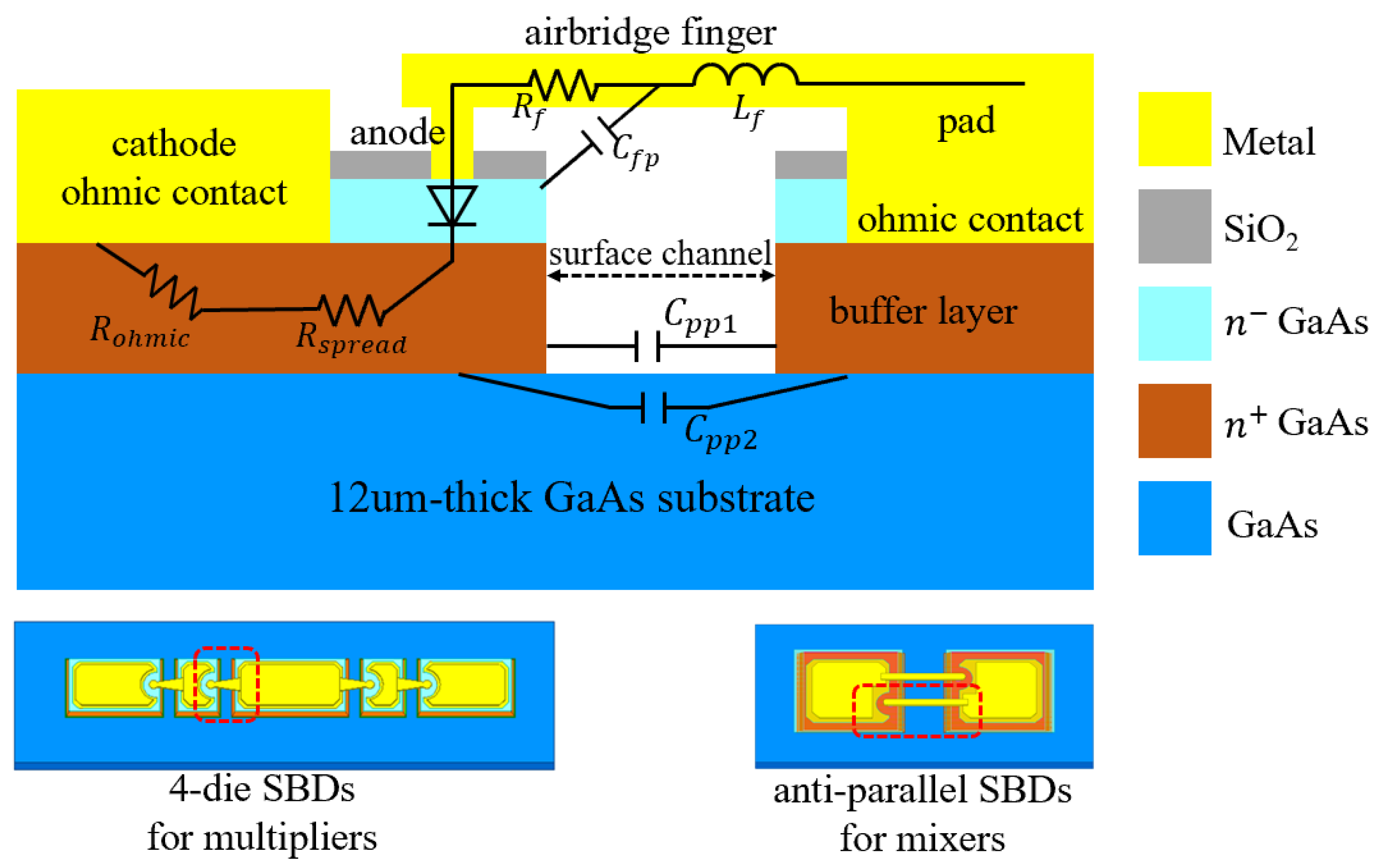
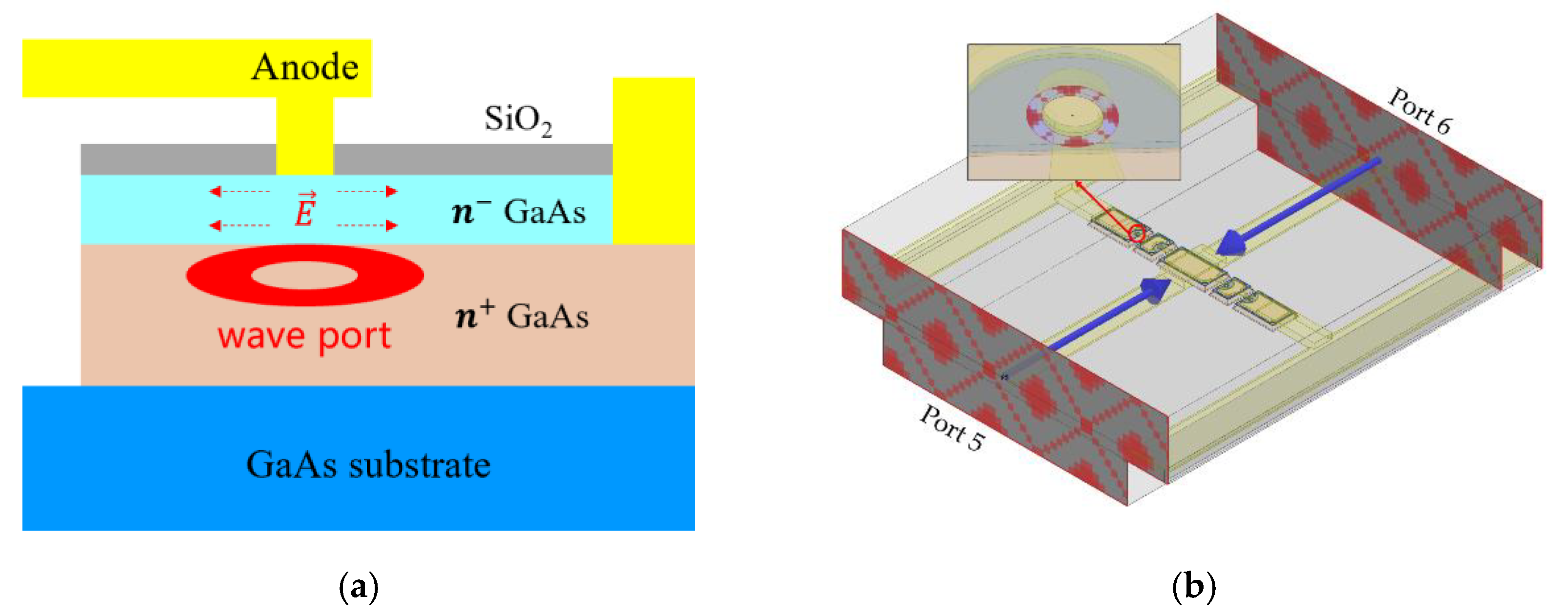
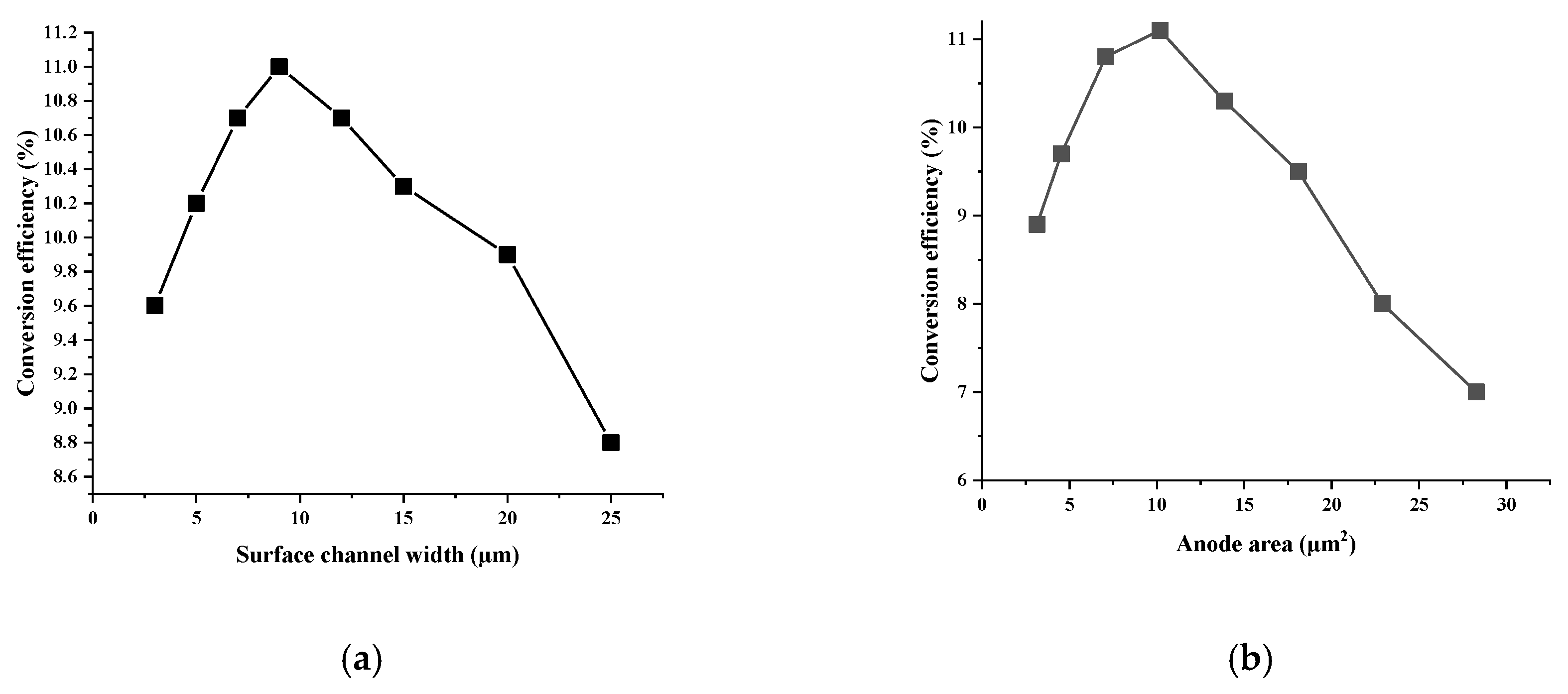
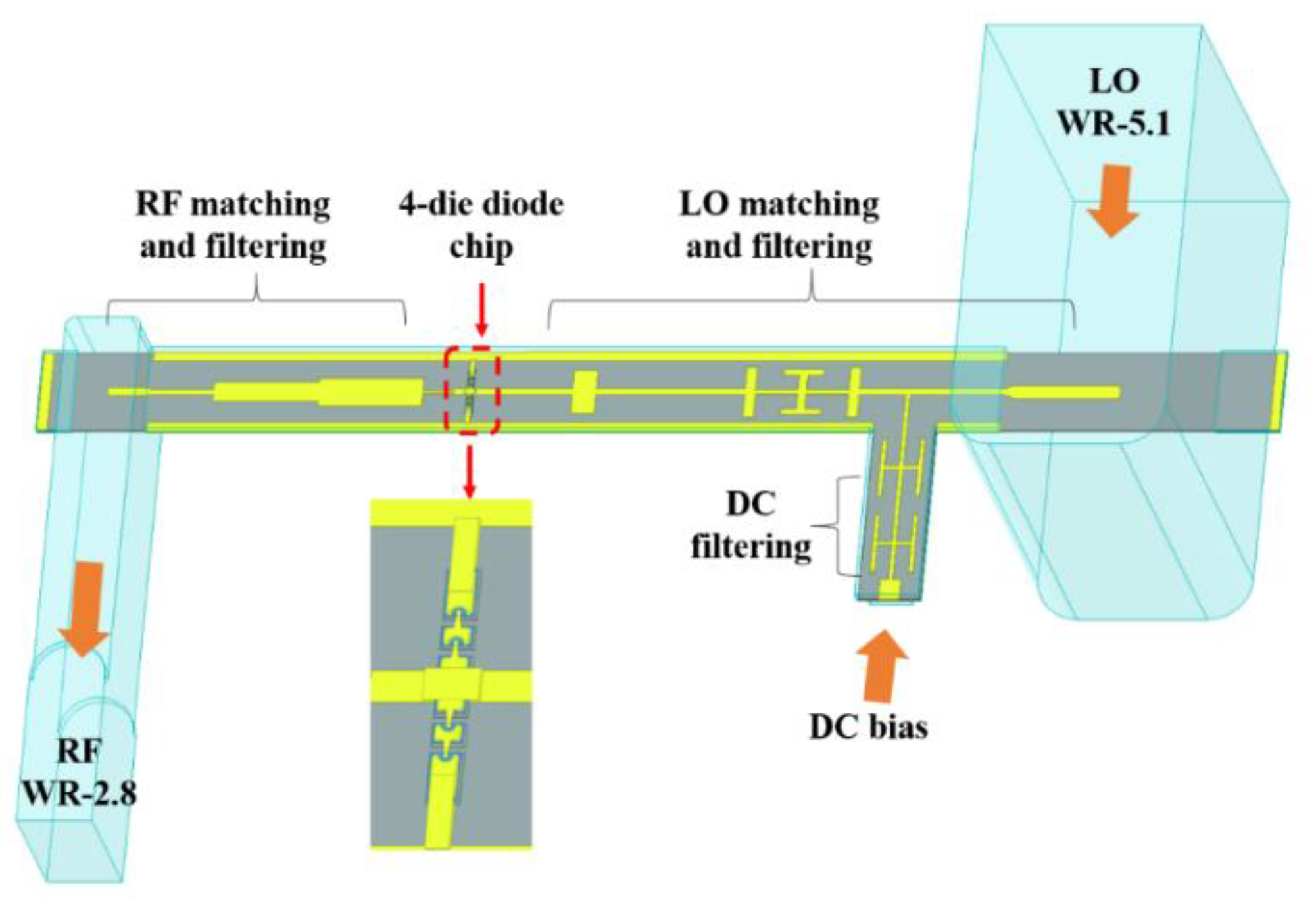
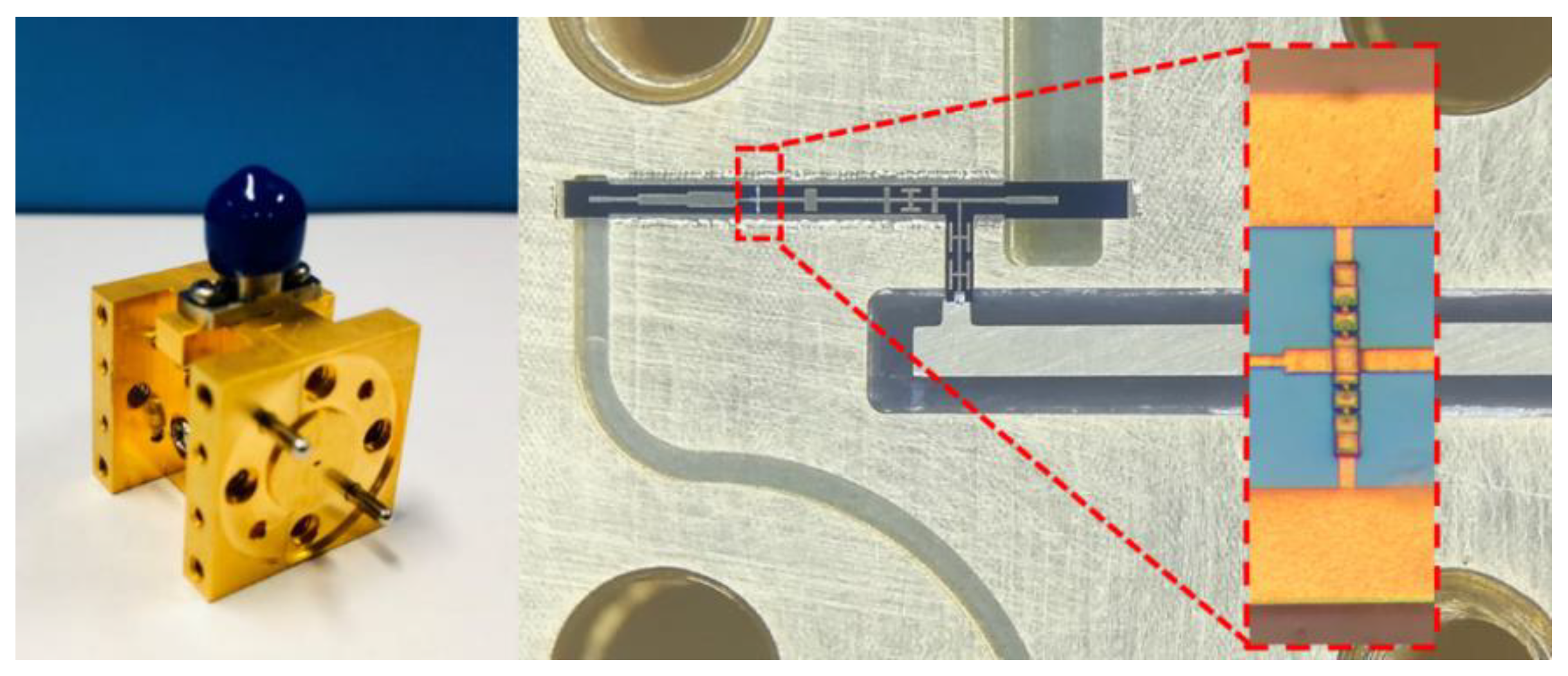

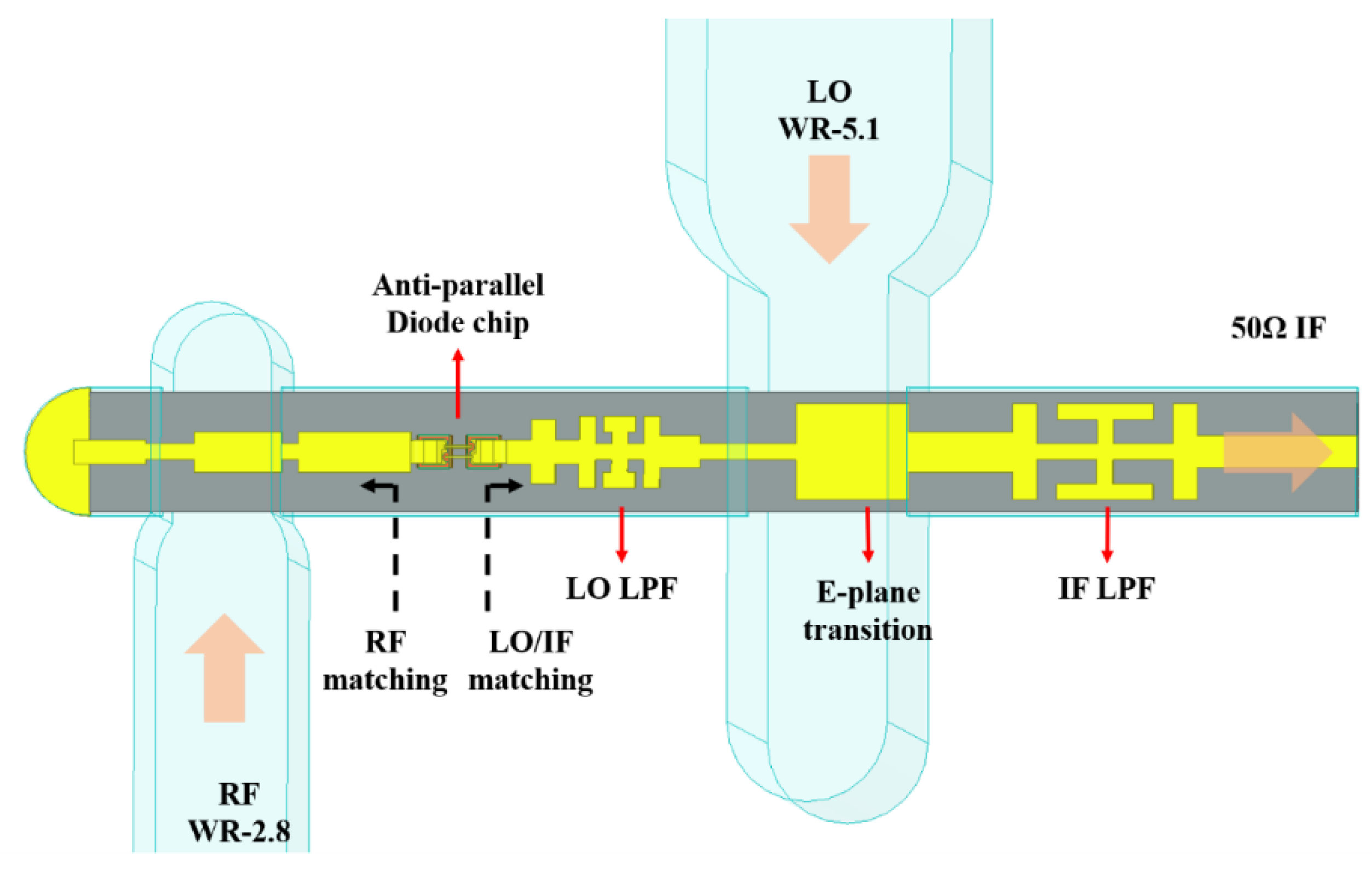
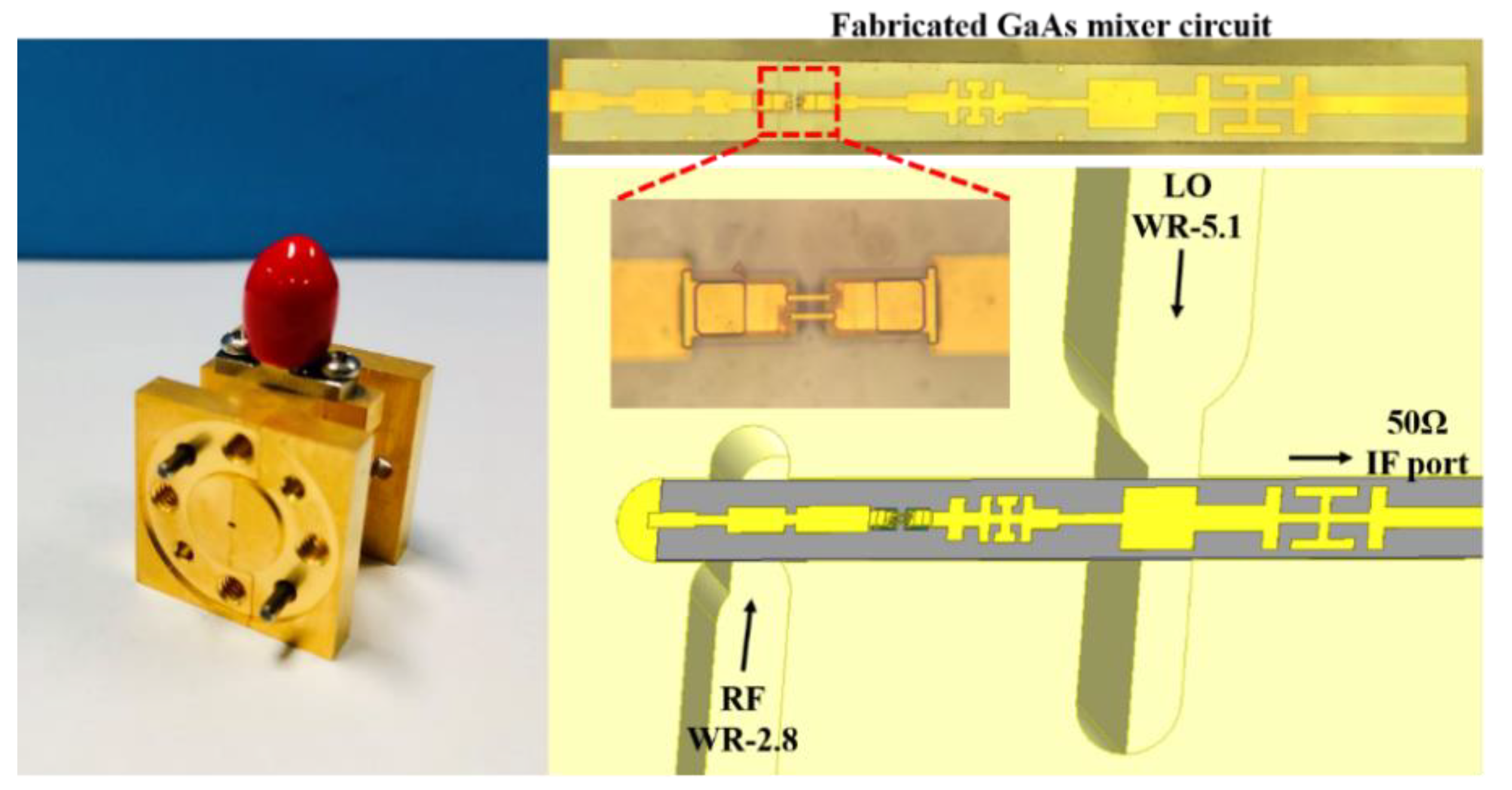




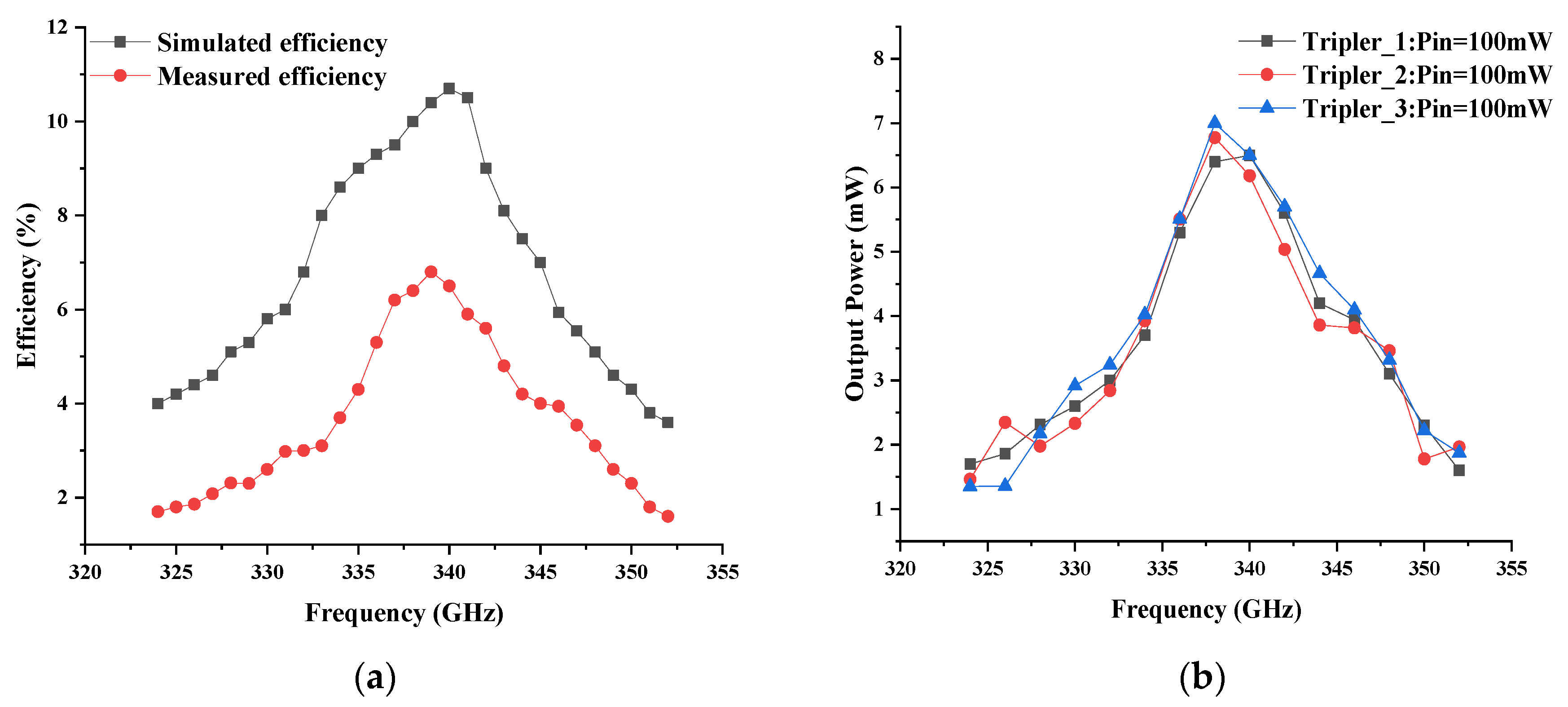

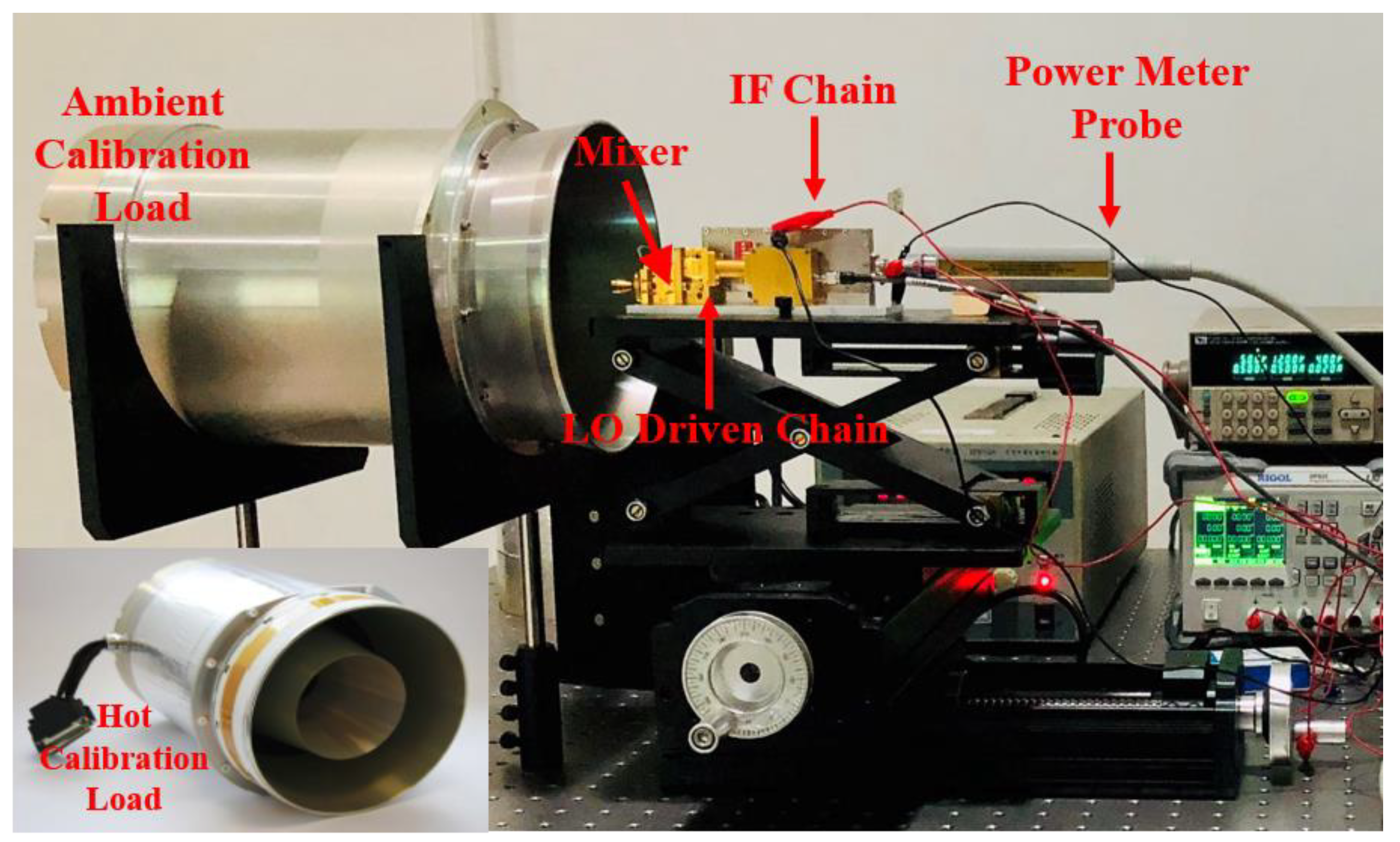
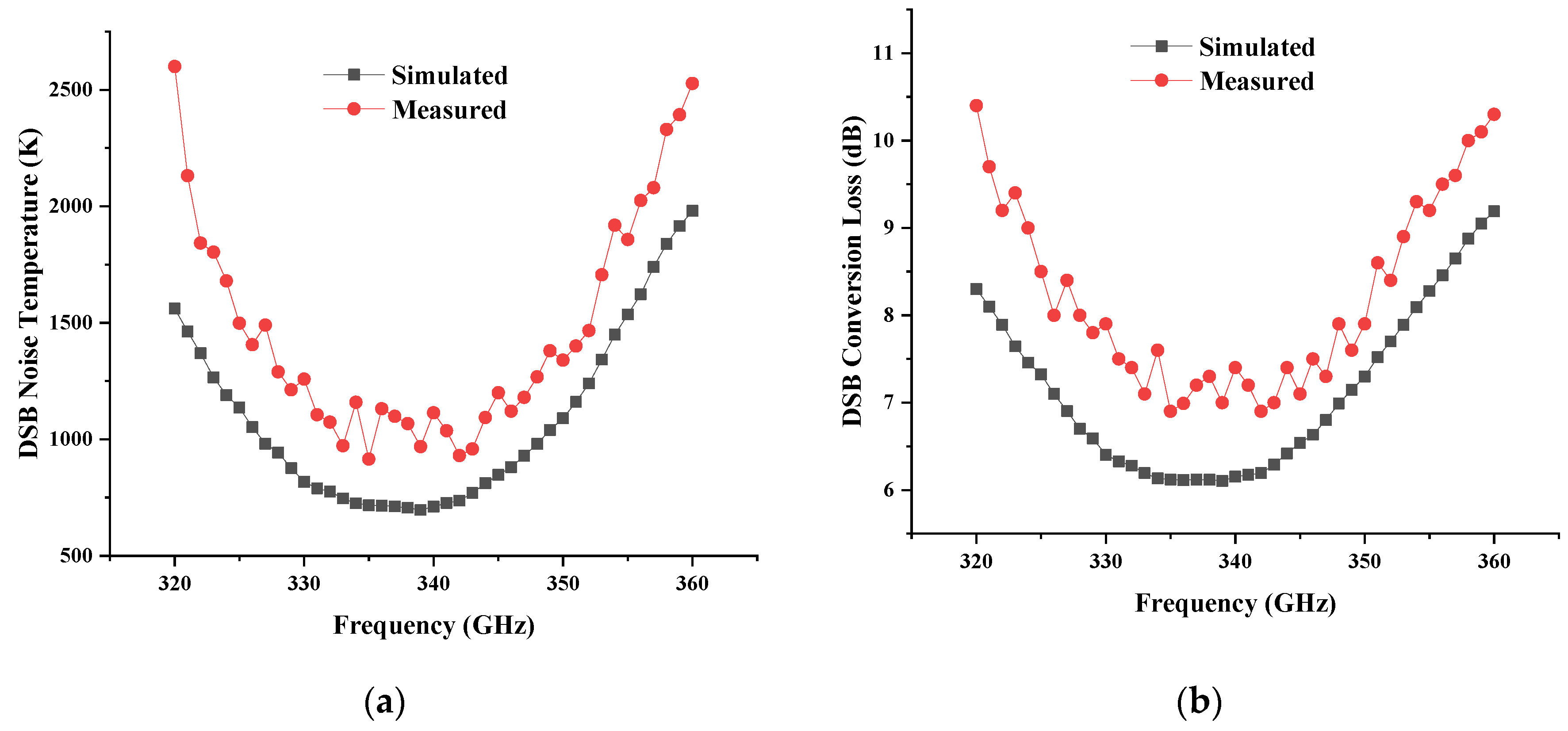
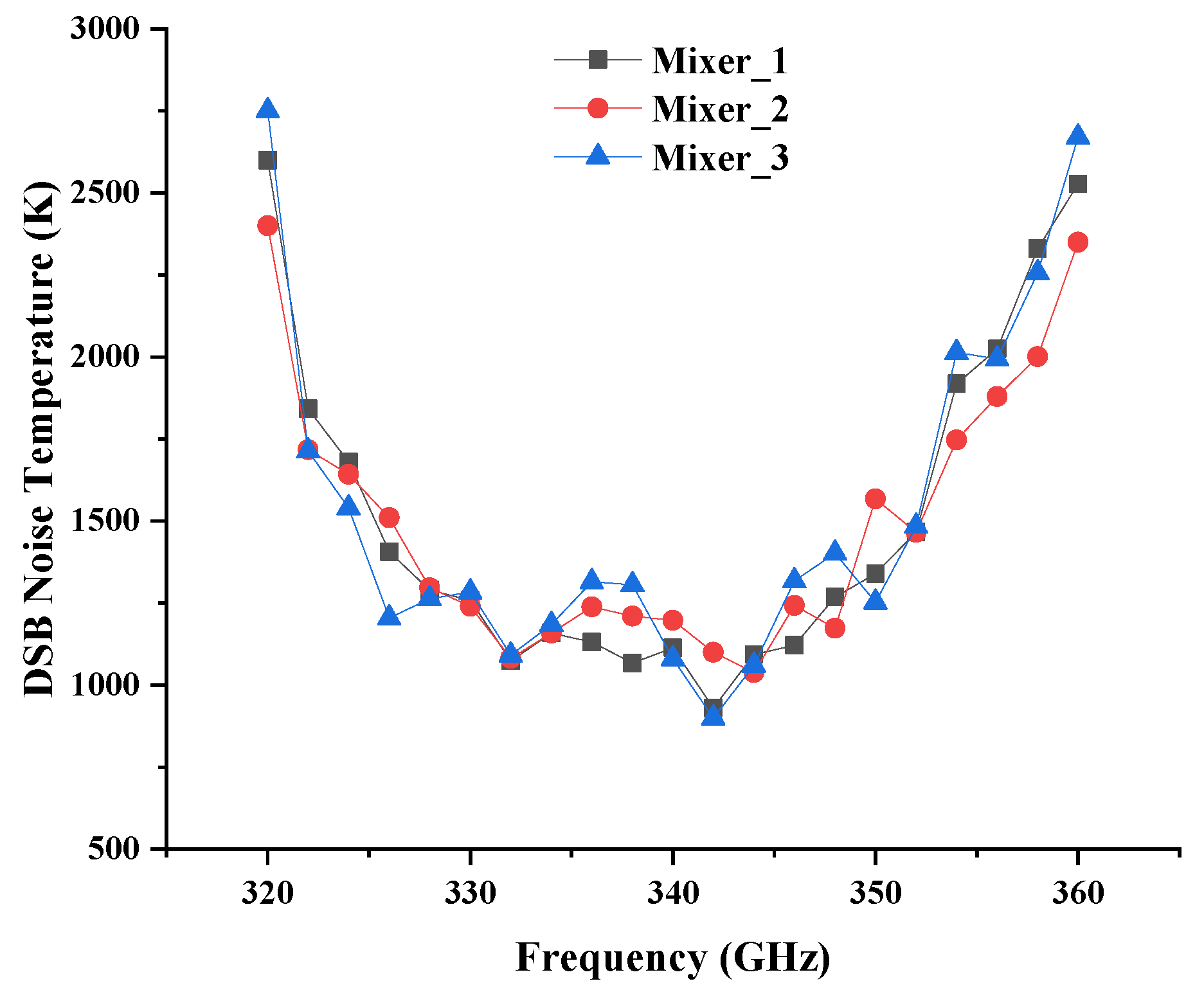
| Physical Parameters | Electrical Parameters | |
|---|---|---|
| Epilayer doping = 2 × 1017 cm−3 | Junction potential (Vj) | 0.9 V |
| Epilayer thickness = 0.3 μm | Zero-bias junction capacitance (Cj0) | 16 fF |
| N+ layer doping = 5 × 1018 cm−3 | Series resistance per anode (RS) | 6 Ω |
| N+ layer thickness = 3.5 μm | Reverse saturation current (Isat) | 2 × 10−17 A |
| Anode radius = 1.8 μm | Reverse breakdown voltage (Vbr) | −9.6 V |
| SiO2 layer thickness = 0.5 μm | Reverse breakdown current (Ibr) | −10 uA |
| Substrate thickness = 12 μm | Ideality factor per anode (η) | 1.2 |
| Chip length = 224 μm Chip width = 28 μm Chip height = 6.3 μm | Grading coefficient (M) | 0.5 |
| Typical cut-off frequency (fT) | 1.5 THz | |
| Physical Parameters | Electrical Parameters | |
|---|---|---|
| Epilayer doping = 2 × 1017 cm−3 | Junction potential (Vj) | 0.9 V |
| Epilayer thickness = 0.1 μm | Zero-bias junction capacitance (Cj0) | 2 fF |
| N+ layer doping = 5 × 1018 cm−3 | Series resistance per anode (RS) | 7 Ω |
| N+ layer thickness = 3 μm | Reverse saturation current (Isat) | 30 fA |
| Anode radius = 0.55 μm | Reverse breakdown voltage (Vbr) | −9.6 V |
| SiO2 layer thickness = 0.5 μm | Reverse breakdown current (Ibr) | −10 uA |
| Substrate thickness = 12 μm | Ideality factor per anode (η) | 1.2 |
| Chip length = 220 μm Chip width = 70 μm Chip height = 6 μm | Grading coefficient (M) | 0.5 |
| Typical cut-off frequency (fT) | 10 THz | |
| Reference | Frequency Range (GHz) | Noise Temperature (K) | Conversion Loss (dB) |
|---|---|---|---|
| [37] | 290–310 | 2000–2600 (SSB) | 9–10 (SSB) |
| [38] | 295–345 | 900 (DSB) (minimum) | 9–13 (SSB) |
| [39] | 320–360 | 900 (DSB) | 9 (SSB) |
| This work | 325–352 | 900–1500 (DSB) | 6–9 (DSB) |
Publisher’s Note: MDPI stays neutral with regard to jurisdictional claims in published maps and institutional affiliations. |
© 2020 by the authors. Licensee MDPI, Basel, Switzerland. This article is an open access article distributed under the terms and conditions of the Creative Commons Attribution (CC BY) license (http://creativecommons.org/licenses/by/4.0/).
Share and Cite
Liu, Y.; Zhang, B.; Feng, Y.; Lv, X.; Ji, D.; Niu, Z.; Yang, Y.; Zhao, X.; Fan, Y. Development of 340-GHz Transceiver Front End Based on GaAs Monolithic Integration Technology for THz Active Imaging Array. Appl. Sci. 2020, 10, 7924. https://doi.org/10.3390/app10217924
Liu Y, Zhang B, Feng Y, Lv X, Ji D, Niu Z, Yang Y, Zhao X, Fan Y. Development of 340-GHz Transceiver Front End Based on GaAs Monolithic Integration Technology for THz Active Imaging Array. Applied Sciences. 2020; 10(21):7924. https://doi.org/10.3390/app10217924
Chicago/Turabian StyleLiu, Yang, Bo Zhang, Yinian Feng, Xiaolin Lv, Dongfeng Ji, Zhongqian Niu, Yilin Yang, Xiangyang Zhao, and Yong Fan. 2020. "Development of 340-GHz Transceiver Front End Based on GaAs Monolithic Integration Technology for THz Active Imaging Array" Applied Sciences 10, no. 21: 7924. https://doi.org/10.3390/app10217924
APA StyleLiu, Y., Zhang, B., Feng, Y., Lv, X., Ji, D., Niu, Z., Yang, Y., Zhao, X., & Fan, Y. (2020). Development of 340-GHz Transceiver Front End Based on GaAs Monolithic Integration Technology for THz Active Imaging Array. Applied Sciences, 10(21), 7924. https://doi.org/10.3390/app10217924




